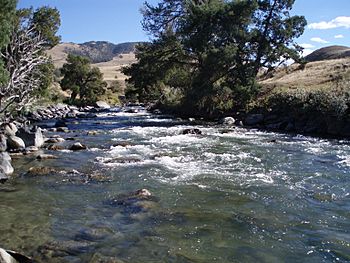Gardner River facts for kids
Quick facts for kids Gardner River |
|
|---|---|

Gardner River near its confluence with the Yellowstone River
|
|
| Country | United States |
| State | Wyoming, Montana |
| Physical characteristics | |
| Main source | Joseph Peak, Yellowstone National Park, Wyoming 44°57′15″N 110°52′03″W / 44.95417°N 110.86750°W |
| River mouth | Yellowstone River Gardiner, Montana 45°01′47″N 110°42′01″W / 45.02972°N 110.70028°W |
| Length | 25 mi (40 km) |
| Basin features | |
| Basin size | 202 sq mi (520 km2) |
| Tributaries |
|
The Gardner River is a river about 25 miles (40 km) long. It flows into the Yellowstone River. You can find it in northwestern Wyoming and south-central Montana in the United States. The entire river is inside Yellowstone National Park.
The Gardner River starts on the side of Joseph Peak. This peak is part of the Gallatin Range in the park's northwest. The river then flows southeast through a wide, high valley called Gardner's Hole. This area is a popular spot for catching trout.
Contents
Fishing in the Gardner River
The Gardner River is a special area for native trout. People who like to fish, called anglers, can catch as many brown and rainbow trout as they want. However, they must release Mountain whitefish and Yellowstone cutthroat trout back into the river. Fishing here follows the rules set by Yellowstone National Park.
River's Journey and Features
After flowing through Gardner's Hole, the river meets other smaller streams. These include Panther Creek, Indian Creek, and Obsidian Creek. Then, the Gardner River turns north. It flows through a deep canyon. Here, the river cuts through ancient rock formations. These rocks were formed from lava about 500,000 years ago. This area is known as Sheepeater Cliffs.
Below Sheepeater Cliffs, two more creeks join the Gardner. These are Glen Creek and Lava Creek. They join the river near Mammoth Hot Springs. The river also crosses the 45th parallel in Gardner Canyon. This means it's halfway between the Equator and the North Pole! The river is also home to a famous hot spring called The Boiling River. The Gardner River continues north through Gardner Canyon. Finally, it flows into the Yellowstone River near Gardiner, Montana.
How the Gardner River Got Its Name
The Gardner River and the nearby town of Gardiner are named after a man named Johnson Gardner. He was a "free trapper" in the early 1800s. This means he hunted animals for their furs on his own. In the 1830s, he worked in the northwestern part of Yellowstone. He sold the furs he caught to the American Fur Company.
Early Explorations of the River
Several early expeditions explored the Yellowstone area.
- On September 13, 1869, the Cook–Folsom–Peterson Expedition entered the park region. They crossed the Gardner River where it meets the Yellowstone River.
- On August 26, 1870, the Washburn–Langford–Doane Expedition also entered the area near Gardiner. They camped near where the two rivers meet. Then they crossed the Gardner River and went south up the Yellowstone River.
Neither of these expeditions explored the Gardner River very deeply. So, they did not find the hot springs at Mammoth Hot Springs.
The Hayden Geological Survey
The Hayden Geological Survey of 1871 was led by Ferdinand Vandeveer Hayden. This survey explored the Gardner River and described Mammoth Hot Springs. However, the Mammoth area was actually named by a person trying to claim land illegally. His name was Harry R. Hohr, and he tried to claim land in early 1871.
Today, a road called the North Entrance Road Historic District runs alongside the lower part of the Gardner River.
Images for kids
-
Eagle Nest Rock, where an Osprey nested in 1921










